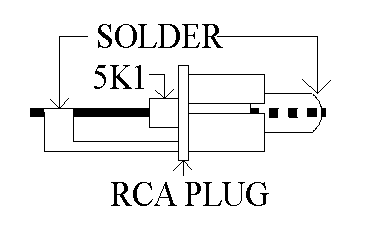
This is a sketch of how to assemble the shorting plug into a Radio Shack RCA plug that has a hollow center pin.
By placing the resistor inside the center pin we get better RF performance. If we a building a 5k1 version of the plug, the RF performance is not that important. If we are building a 75 ohm version, we are a little concerned about the RF performance.
The important things to remember:
1. Keep the leads short.
2. Don't let the lead to the center pin touch the shell or outer shield
connection.
3. If the solder joint is not shiny, it is not a good solder joint.
4. If the solder joint is grainy, the solder is contaminated and should
be removed and resoldered.
5. Clean all the flux off the solder joints after soldering.
6. After the outer plastic cover is installed, ohm the connections
out.

You can use 2K up to 10K in this plug when it is used for audio.
Don't waste a gold RCA on this! Use the cheapest RCAs Radio Shack has
to make this.
Don't waste a HOLCO on this! Cheap metal film resistors work just fine.
NEVER build one of these that is a direct short, you could accidentally destroy your equipment by putting a direct short on the output of some equipment. Always have at least 51 ohms for the resistor value.
If you can't get the RCA with the big hole in the middle for the resistor, make sure the center lead (right lead above) cannot touch the ground connection (left lead above). Use sleeving or insulating tape if necessary.
75 ohm resistor value:
It was reported a long time ago that if you made plugs like the one above with 75 ohm resistors and plugged these 75 ohm plugs into un-used video and CD player digital outs, your system would sound better. Back when I tried it, my system was not as good as it is now and I did not hear a difference. Now my system is better and I need to make a few 75 ohm terminators to try it out. 75 ohms on an audio input won't hurt anything, but it could mask a hum problem because it is too low in ohms. 75 ohms on an audio output could overheat a signal source.2K to 10K resistor value:
1. This can be plugged into the output of preamp to place a load on the output for testing purposes.2. This can be plugged into the input of an amp or preamp to help check noise levels and to verify sources of hum.
First edition 11/18/00, last update 01.22.02 I don't change the update date on individual sections for minor corrections. I only change the date for content changes.